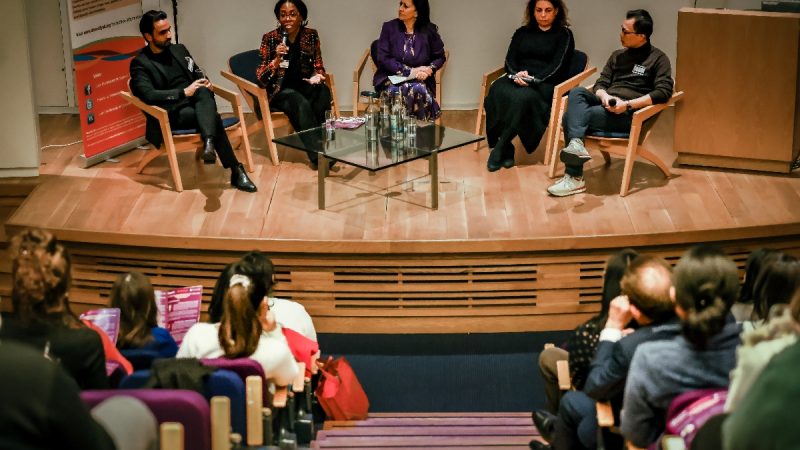Fawcett Society: Women of colour missing from UK’s top jobs

The Fawcett Society is today publishing its 2022 Sex and Power Index – the biennial report which charts the progress towards equal representation for women in top jobs across the UK. Yet again, the report reveals the pace of change is glacial in the majority of sectors and shows that women are outnumbered by men 2:1 in positions of power.
The data also shows that women of colour are under-represented at the highest levels in many sectors and alarmingly, reveals that they are missing altogether from senior roles such as Supreme Court Justices, Metro Mayors, Police and Crime Commissioners and FTSE 100 chief executives.
While overall progress is far too slow, the report shows that women’s representation has improved in a minority of key areas with the Scottish Parliament, London Assembly, Combined Authorities and Local Economic Partnerships (LEPs) having made solid progress towards equality since the last Sex and Power Index was published in 2020. This clearly shows that progress is possible and there are lessons to be learned in sectors such as sport. The sporting sector not only has very few women in leadership roles, but this year’s Sex & Power Index has revealed a progressive decline in the number of female sport governing body chairs (15% in 2022 from 20% in 2020) and CEOs (19% in 2022 from 21% in 2020).
Jemima Olchawski, CEO, The Fawcett Society said:
"The people who hold the top jobs in our society have enormous power to shape our democracy, culture and economy. Yet men continue to dominate most senior roles. That’s not only bad for the women who miss out on opportunities to thrive, but it’s bad for us all, as we miss out on women’s talent, skills and perspectives. What is most alarming about today’s data is that it shows an unacceptable lack of women of colour in senior positions. It is appalling that in 2022, women of colour are missing in leadership positions from some of our key institutions and organisations. Put simply, this gives the lie to the idea that we live in a meritocracy or a society of equal opportunity. Structures, culture and often individuals continue to create barriers that prevent women and women of colour in particular rising to the top. And we’re all losing out as a result."
Too few women in positions of power is one of the causes of the gender pay gap and the complete lack of women of colour in top jobs in many sectors also feeds the ethnicity pay gap. It is essential that this Government introduces intersectional ethnicity pay gap reporting and gets to grips with inequalities in our society that hold back women of colour.
Dianne Greyson, Founder #EthnicityPayGap Campaign:
"The Ethnicity Pay Gap Campaign is renewing its calls on the Government to introduce mandatory ethnicity pay gap reporting. This is a key step in addressing structural barriers that stop women from ethnic backgrounds progressing into positions of power. Our recent research shows that Black women experience pay disparity based on their race and are significantly held back in their career progression because of structural racism. It also highlights the considerable mental and physical pressures placed upon Black women in the workplace. We want to see companies eradicate the cultural and systemic practices that impact women from an ethnic background."
Sex and Power 2022 shows:
Parliaments and Politics: The last two Westminster elections have seen scant progress, the proportion of female MPs moving from 32% in 2017 to 34% at the 2019 election.
Business: Women remain just 8% of FTSE 100 CEOs, and none are women of colour. Women hold 37.7% of non-executive directorships, but just 13.7% of executive directorships.
Education: Women account for 65% of secondary school teachers, but only 40% of headteachers. Just 6% of those headteachers are women from ethnic minority backgrounds.
Media: The proportion of women editing national newspapers has risen to 42%, whilst the number of female political editors remains low at 12%.
Cabinet: The proportion of women in Cabinet has fallen back to just over a quarter (26%) and only 24% of Cabinet Committee positions are held by women
Local Government: Women make up 35% of councillors across England, 22% of local council leaders, and 26% of Police and Crime Commissioners. There are now greater numbers of women on combined authority boards - 37%, and women make up 52% of London Assembly members.
Civil Service: Of the 16 government departments run by permanent secretaries, six are run by women and none are run by women of colour. Women’s representation among the Civil Service Board stands at 45% women.
The Law: Women make up 27% of Court of Appeal judges and 30% of High Court judges. There are just two female Supreme Court Justices and no women of colour.
Sport: On individual sport bodies, only three CEOs, out of 22 organisations, are women (14%) This is a sharp decline from the 2020 Sex and Power report where women made up 21% of chief executives. Of all-time Premier League clubs, women make up 5% of chief executives.
Health: The number of women chairing NHS trusts is getting closer to parity at 41% and 45% of trusts have a female chief executive. Amanda Prichard has become the first female NHS England chief executive.
Civil Society: Women represent one in three chief executives of the largest 100 charities by income at 36%. Our analysis of 22 professional bodies found that women made up 24% of chief executives and 48% of chairs.
Jemima continues:
"The pandemic has laid bare the deep-rooted inequalities across the UK. Yet it is women who have borne the brunt and often largely invisible from debate and excluded from decision-making. Women of colour, disabled women, young women and mothers have been at the sharpest end. At the height of the pandemic only two out of 56 Government press briefings were led by a female politician and women were underrepresented across all covid-19 advisory groups. It begs the question then, what if more women were at the table and making key decisions, would women across our society have felt the impact of political decisions throughout the pandemic so severely?"
Women’s representation in the COVID-19 crisis:
The Index shows that at the height of the pandemic, women were underrepresented across the Scientific Advisory Group for Emergencies (SAGE) and related subgroups:
- Scientific Advisory Group for Emergencies (SAGE) - 28%
- Scientific Pandemic Insights Group on Behaviours (SPI-B) - 39%
- Scientific Pandemic Influenza Group on Modelling (SPI-M) - 24%
- COVID-19 Clinical Information Network (CO-CIN) - 11%
- New and Emerging Respiratory Virus Threats Advisory Group (NERVTAG) - 20%
- Environmental Modelling Group (EMG) - 21%
- Joint Committee on Vaccination and Immunisation (JCVI) - 25%
The Fawcett Society continues to call on Government to ensure more women are at the decision-making table. As of November 2021, only 92 of the 274 (34%) people on our COVID-19 advisory boards are women.
Women’s representation across all sectors is a vitally important step to advancing gender equality and, as research continues to show, it is good for business.
Fawcett’s Sex & Power 2022 calls for change include:
- Targets set to increase the number of women in positions of power and actions plans put in place to ensure they are met.
- Improved Pay Gap Reporting – which includes intersectional ethnicity pay gap reporting, the threshold for reporting reduced to employers with 100+ employees, and publication of mandatory action plans.
- Action plans must be established by co-ordinating bodies in sectors where women of colour are missing from the top.
- Flexible working as default for all job roles, where it is reasonably possible.
Fawcett’s 2022 Sex & Power Index can be found here: www.fawcettsociety.org.uk/sex-power-2022




